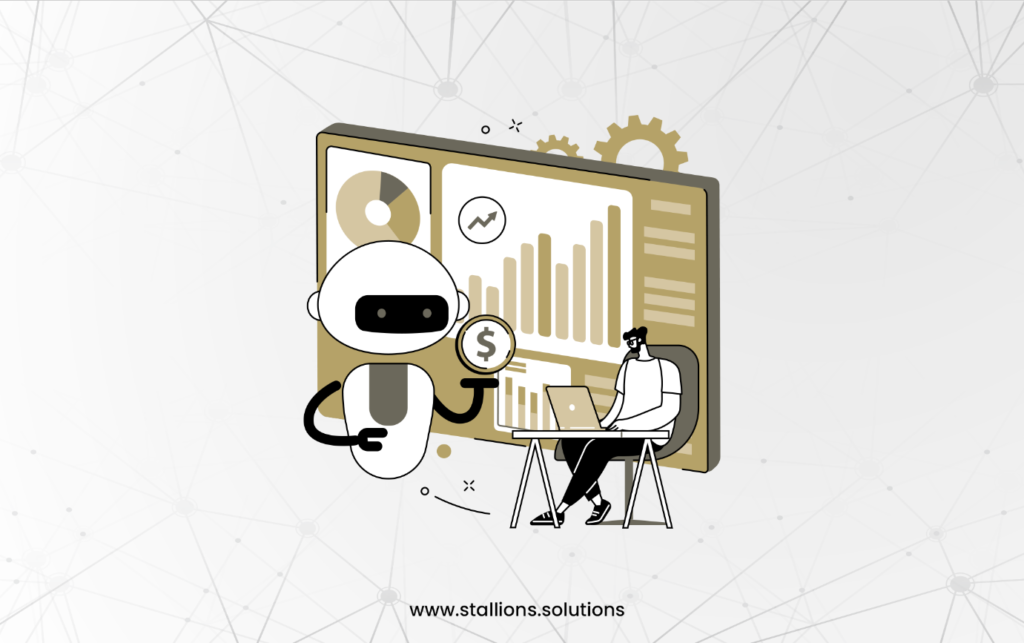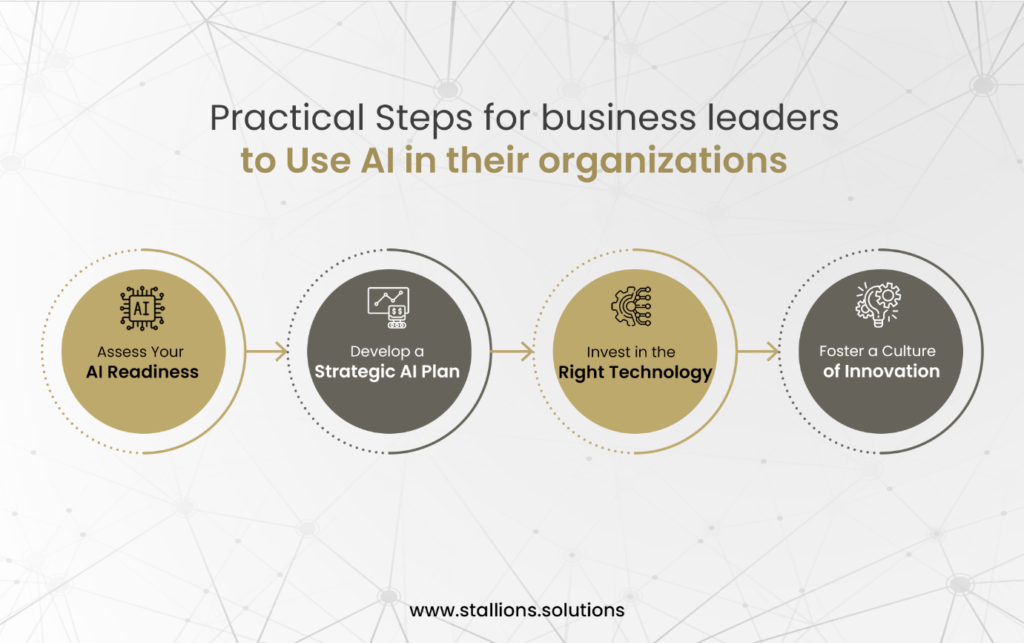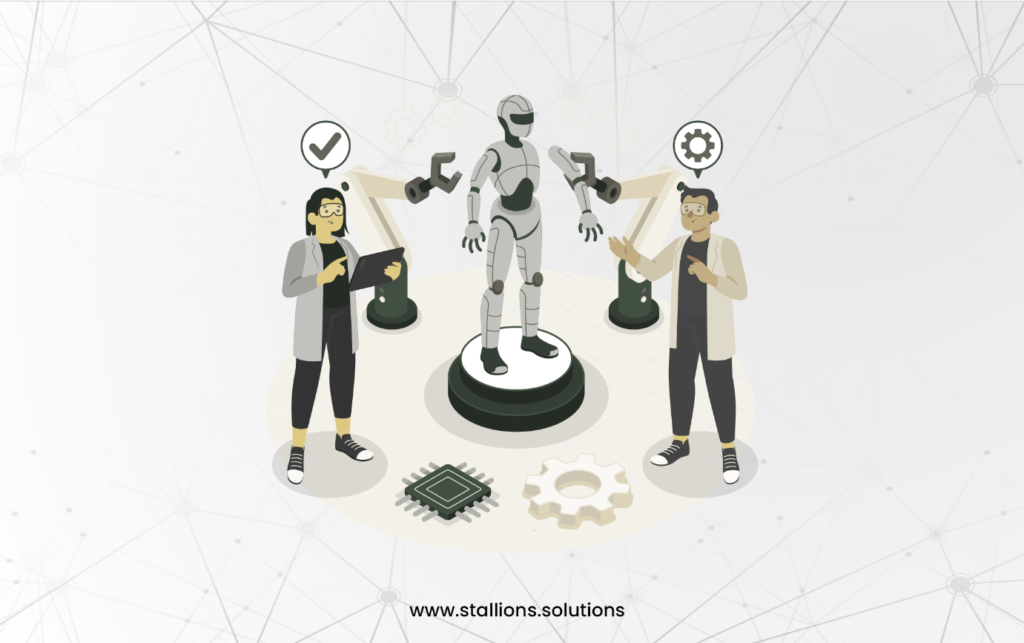Artificial Intelligence (AI) is transforming industries, helping businesses operate more efficiently, make smarter decisions, and create better customer experiences. Businesses like Coca-Cola, Amazon, and Netflix have been quick to use AI to make better decisions, speed up business tasks, and boost creativity. However, many business leaders still struggle to understand how to use AI in their companies effectively. Here are some essential steps to get started.
Challenges Leaders Face When Implementing AI in Their Business Strategies
Despite its great potential, business leaders face several challenges when implementing AI into their business strategies. Let’s look at some of the most common challenges they face:
Cost Expectations

For many business leaders, the cost can make or break their AI journey. While AI solutions promise many benefits, most expenses come from deployment, maintenance, and potential upgrades. Company owners should always be ready for unexpected cost increases. More resources, such as specialized staff, hardware, and software, may be needed more often than initially expected. Additionally, existing staff may need further training to keep up with complex models and constantly changing algorithms.
Data Quality and Management: Many companies struggle to ensure their data is accurate, consistent, and accessible. According to a survey, 39% of corporate executives see data quality as a significant challenge to adopting AI. Poor data quality can lead to incorrect insights and reduced effectiveness of AI models.
Talent Scarcity

Building effective AI teams is challenging due to a severe shortage of experienced AI specialists. Gartner predicts that by 2025, the adoption of AI in major enterprises will be 30% slower due to a lack of expertise in AI roles. This talent gap could be a significant hurdle for AI adoption.
Integration with Existing Systems: Integrating AI solutions with legacy systems can be difficult and resource-intensive. This challenging process can slow down AI adoption and affect its effectiveness.
Ethical and Privacy Concerns: AI use raises data privacy and ethical concerns, such as bias in AI systems. Addressing these issues is crucial for building trust and ensuring compliance with regulations.
Organizational Resistance: AI adoption can be hindered by resistance to change within the organization. Employees may be wary of new processes due to a lack of trust in emerging technology or fear of losing their jobs.
Demonstrating ROI: Proving AI initiatives’ return on investment (ROI) can be difficult, especially in their early stages. PwC’s Global AI Study suggests that AI has enormous potential to grow businesses, potentially boosting the world economy by up to $15.7 trillion by 2030. To maintain investment, business leaders must demonstrate measurable returns.
By addressing these challenges early in the process, management can create a more favorable environment for AI adoption and maximize its benefits. The next section offers practical steps for business leaders to implement AI in their organizations and avoid setbacks in the implementation journey.

Step 1: Check If Your Company Is Ready for AI
Before starting with AI, make sure your company is prepared. It means checking your skills, finding gaps, and making a clear plan.
Take a Readiness Assessment
First, look at your team, technology, and data. Use tools like the AI Readiness Model to see where you stand. Find areas where you need improvement, like data quality, tech skills, or understanding AI.
Create a Vision and Plan
Decide what you want to achieve with AI. Your AI projects should match your business goals, whether improving customer service, making operations more efficient, or driving innovation. Research shows 76% of CEOs believe AI is key to their business plan. Clear goals will guide your AI strategy and ensure every action has a purpose.
Include Stakeholders
Get support from company leaders. Show them the potential benefits of AI projects. Form a team with people from different areas—experts, engineers, data scientists, and business leaders. This diverse team will help implement AI effectively.
Step 2: Make a Strategic AI Plan
Once you know your goals and are ready, create a strategic AI plan. Focus on how you will use AI and what you want to achieve. This includes choosing the right technology, investing in data management, and starting with pilot projects.
Start with Pilot Projects
Identify areas where AI can quickly show results. According to the Harvard Business Review, companies using AI often see profit margins increase by 3-5%. Test AI on a small scale first to demonstrate its benefits before expanding.
Invest in Data Management

Good data management is crucial for AI. Set up data pipelines to collect and combine information from different sources. McKinsey says companies with strong data governance see 2.5 times more benefits from AI. Adopt procedures to keep your data secure, consistent, and accurate. For instance, Coca-Cola invested in data integration to improve its supply chain and AI-driven marketing.
Choose the Right Technologies
Pick AI platforms and technologies based on your needs. Think about support, scalability, and ease of use. Decide whether to work with external vendors or develop AI solutions internally. For example, Amazon uses in-house and external solutions for its AI-powered logistics and customer support.
Step 3: Invest in the Right Technologies
Boost your company’s efficiency by using scalable AI technologies and focusing on automation. Here’s how:
Use Scalable AI Solutions
Choose cloud-based AI systems that are cost-effective and flexible. These platforms have pre-built tools and models that make development and implementation faster. For example, Amazon expands its AI capabilities easily with cloud-based technologies.
Focus on Automation

AI can automate routine tasks, allowing employees to focus on more important work. Forrester predicts that by 2025, AI will create new jobs equal to 9% of the current workforce. Use automation to boost productivity and streamline operations. For instance, Coca-Cola uses AI to automate its supply chain, reducing costs and improving efficiency.
Enhance Decision-Making
Explore how AI can improve decision-making in your business. AI-powered analytics can provide predictive insights to help you make better decisions. For example, Netflix uses AI to analyze user data and predict viewing habits, offering personalized content to improve customer satisfaction.
Step 4: Build a Culture of Innovation
To make AI work well in your company, create a culture that encourages teamwork, experimentation, and learning.
Promote AI Literacy
Offer training on AI basics and tools for your employees. Identify AI advocates within the company to lead and share knowledge. Deloitte found that 94% of executives see AI as crucial for innovation. For example, Amazon provides ongoing education to keep its employees updated on AI.
Encourage Experimentation
Set up innovation labs or centers to test AI technology and create prototypes. Motivate employees to develop AI solutions by offering rewards and recognition.
Boost Collaboration
Encourage teamwork between different departments, engineers, and data scientists to build AI solutions. Partner with startups, research institutes, and external experts to stay ahead in AI innovation.
Conclusion
Leaders today need clear strategies to successfully use AI. Start by checking if your business is ready, investing in the right technology, and fostering creativity. By following the practical steps outlined in this blog, business leaders can harness AI to drive change and achieve their goals.
To stay competitive, keeping up with the latest AI trends, best practices, and ethical considerations is essential. Learn from industry experts and academic research to navigate the AI landscape effectively. By doing so, you’ll be well-prepared to lead your company into the future and fully realize the potential of AI.



